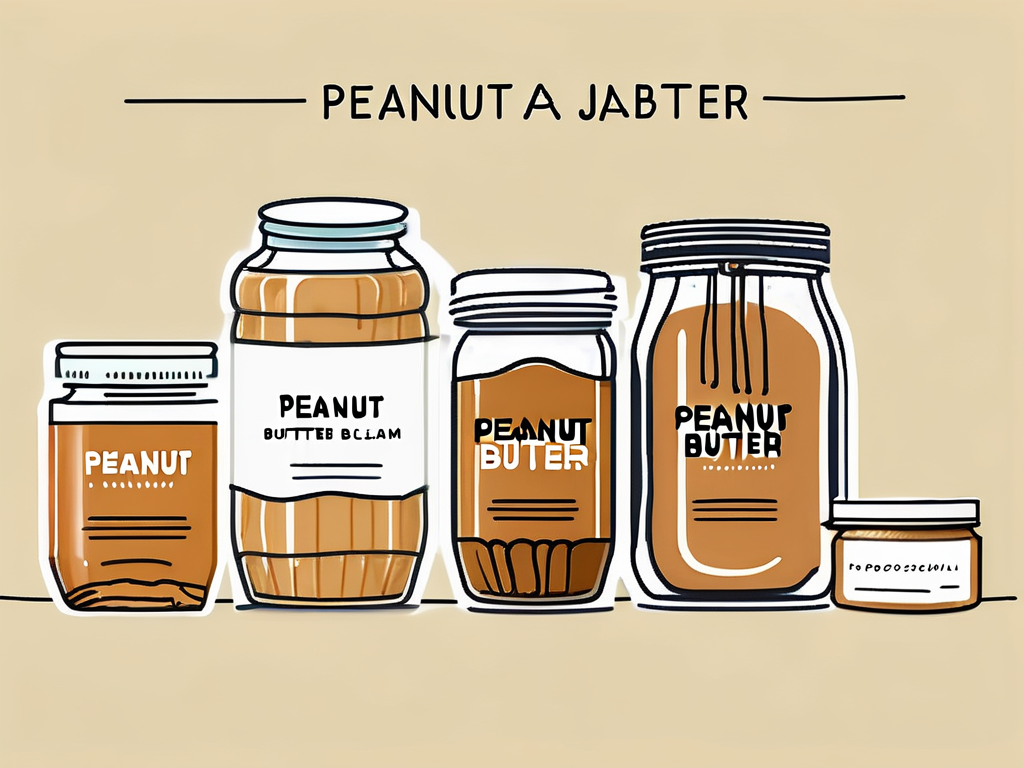Peanut butter is a popular and beloved spread enjoyed by many. However, for individuals with digestive sensitivities, such as those following a low FODMAP diet, finding suitable options can be a challenge. In this guide, we will explore the world of peanut butter from a low FODMAP perspective, understanding its connection to FODMAPs, how to choose the right peanut butter, incorporating it into your diet, and the potential health benefits it offers.
Understanding FODMAPs and Their Role in Digestion
Before delving into the peanut butter options, let's first understand what FODMAPs are and their significance in digestive health. FODMAPs, which stands for Fermentable Oligosaccharides, Disaccharides, Monosaccharides, and Polyols, are a group of carbohydrates that some individuals find difficult to digest. These carbohydrates can ferment and produce gas in the gut, leading to symptoms such as bloating, abdominal discomfort, and altered bowel movements.
What are FODMAPs?
FODMAPs are commonly found in various foods and food additives. They include fructose (found in fruits, honey, and some sweeteners), lactose (found in dairy products), fructans (found in wheat, onions, and garlic), galacto-oligosaccharides (found in legumes), and polyols (such as sorbitol and mannitol, found in certain fruits and artificial sweeteners).
How FODMAPs Affect Digestion
For individuals with sensitive digestive systems, FODMAPs can cause discomfort by drawing water into the intestines and being rapidly fermented by gut bacteria. This fermentation process can lead to the production of gas and bloating, contributing to gastrointestinal symptoms.
The Importance of Low FODMAP Diet
A low FODMAP diet is an eating plan that restricts foods high in FODMAPs and has been found to alleviate digestive symptoms in individuals with irritable bowel syndrome (IBS) and other functional gastrointestinal disorders. By reducing the intake of FODMAPs, individuals can potentially reduce symptoms and improve their overall quality of life.
When following a low FODMAP diet, it is important to work with a registered dietitian or healthcare professional who specializes in gastrointestinal disorders. They can help create a personalized meal plan that ensures proper nutrition while minimizing FODMAP intake.
It's worth noting that the low FODMAP diet is not a long-term solution. It is typically followed for a specific period, usually around 2-6 weeks, to identify trigger foods and assess symptom improvement. After this elimination phase, FODMAPs are gradually reintroduced to determine individual tolerance levels.
It is also important to remember that not all individuals will experience the same level of sensitivity to FODMAPs. Some people may be able to tolerate certain high FODMAP foods in small amounts without experiencing symptoms, while others may need to avoid them completely.
Overall, understanding FODMAPs and their role in digestion can provide valuable insights into managing digestive symptoms. By implementing a low FODMAP diet under the guidance of a healthcare professional, individuals can take control of their digestive health and improve their overall well-being.
The Connection Between Peanut Butter and FODMAPs
Now that we have a better understanding of FODMAPs, let's explore the relationship between peanut butter and these fermentable carbohydrates.
When delving into the world of peanut butter and its impact on FODMAPs, it's essential to consider not only the nutritional benefits but also the potential challenges it may present for those sensitive to certain fermentable carbohydrates.
Nutritional Profile of Peanut Butter
Peanut butter, made from ground roasted peanuts, is known for its rich flavor and creamy texture. It is also a good source of protein, healthy fats, and various essential vitamins and minerals. The combination of protein and healthy fats makes peanut butter a popular choice for those looking to incorporate a nutritious spread into their diet.
Furthermore, the versatility of peanut butter allows it to be used in a variety of dishes, from classic PB&J sandwiches to savory peanut sauces in Asian cuisine. This adaptability adds to its appeal as a pantry staple for many households.
FODMAP Content in Peanut Butter
While peanuts themselves are considered low in FODMAPs, certain factors can contribute to higher FODMAP content in some peanut butter products. These factors include the presence of added sugars or high FODMAP ingredients like honey, wheat, or artificial sweeteners. It's important to read labels carefully and choose peanut butter without such additions if following a low FODMAP diet.
Moreover, the processing methods used to create peanut butter can also influence its FODMAP content. Some commercial peanut butter brands may add emulsifiers or stabilizers that contain FODMAPs, potentially affecting individuals with sensitivities. Opting for natural peanut butter made solely from peanuts can help mitigate this issue.
Choosing the Right Low FODMAP Peanut Butter
When looking for low FODMAP peanut butter options, there are a few key ingredients to consider and labels to examine. Let's explore them further.

Low FODMAP peanut butter can be a delicious and safe option for individuals following a low FODMAP diet. It is essential to pay attention to the ingredients used in the peanut butter to ensure it aligns with your dietary needs. Opting for peanut butter made with only simple and natural ingredients, such as peanuts and salt, can help you avoid unnecessary additives that may trigger digestive issues.
Key Ingredients to Look For
Opt for peanut butter made with only simple and natural ingredients, particularly peanuts and salt. Avoid products with added sugars, honey, molasses, or high FODMAP ingredients like wheat or artificial sweeteners. By choosing minimal ingredient peanut butter, you can reduce the risk of consuming excess FODMAPs.
Additionally, checking for the presence of other potential allergens, such as tree nuts or soy, is crucial if you have known sensitivities. Some manufacturers may process their peanut butter in facilities that also handle these allergens, leading to cross-contamination risks.
Reading Labels for FODMAP Content
Always take the time to carefully read the nutritional labels of peanut butter products. Look out for any high FODMAP ingredients mentioned in the list, and ensure that the product does not contain any added sugars or artificial sweeteners. Opting for peanut butter that is explicitly labeled as "low FODMAP" can provide additional assurance.
Furthermore, consider the texture of the peanut butter – whether you prefer it smooth or chunky. Some individuals find that chunky peanut butter contains whole peanuts that may be harder to digest, while others enjoy the added crunch. Experimenting with different textures can help you determine which type works best for your digestive system.
Incorporating Low FODMAP Peanut Butter into Your Diet
Now that you have selected the right low FODMAP peanut butter, let's explore creative and delicious ways to incorporate it into your diet.

Low FODMAP peanut butter is not only a tasty addition to your meals but also a versatile ingredient that can elevate your dishes in various ways. Its creamy texture and nutty flavor make it a perfect companion for both sweet and savory dishes. Whether you're looking to enhance the taste of your breakfast, lunch, or dinner, low FODMAP peanut butter can be your go-to ingredient.
Delicious and Digestive-Friendly Recipes
Low FODMAP peanut butter can be used in various recipes to add flavor, texture, and a nutritional boost. From classic peanut butter and banana sandwiches to adding it to smoothies, oatmeal, or even using it as a dip for fresh fruits and vegetables, the options are endless. Experiment with different recipes and find what works best for your taste and digestive needs.
For a quick and nutritious snack, try spreading low FODMAP peanut butter on rice cakes and topping them with sliced strawberries or a sprinkle of chia seeds. This simple yet satisfying snack is not only delicious but also provides a good balance of carbohydrates, protein, and healthy fats.
Tips for Moderation and Balance
Although low FODMAP peanut butter can be enjoyed as part of a healthy and balanced diet, it's important to consume it in moderation. Peanut butter is calorie-dense, so make sure to pay attention to portion sizes to avoid overconsumption. Moderation is key to maintaining a balanced diet and preventing any potential negative effects.
When incorporating low FODMAP peanut butter into your meals, consider balancing it with other nutrient-dense foods such as fresh vegetables, lean proteins, and whole grains. This will not only enhance the nutritional value of your meals but also help you feel satisfied and energized throughout the day.
Potential Health Benefits of Low FODMAP Peanut Butter
Peanut butter, when consumed as part of a low FODMAP diet, can offer various health benefits beyond its delicious taste. Let's take a closer look.
Impact on Gut Health
Choosing low FODMAP peanut butter can support gut health in individuals with digestive sensitivities, especially those with IBS. By reducing FODMAP intake, individuals may experience a reduction in common gastrointestinal symptoms, leading to an improved overall sense of well-being.
Other Nutritional Benefits
In addition to its gut health benefits, low FODMAP peanut butter is a good source of protein, healthy fats, and essential nutrients such as vitamin E, magnesium, and niacin. These nutrients play vital roles in supporting overall health and well-being, making peanut butter a valuable addition to a balanced diet.
In Conclusion
Peanut butter can be enjoyed on a low FODMAP diet with careful consideration of FODMAP content and ingredient selection. By choosing the right low FODMAP peanut butter options, incorporating it into delicious recipes, and consuming it in moderation, individuals can continue to enjoy the taste and potential health benefits while maintaining digestive comfort. As always, it is recommended to consult with a healthcare professional or registered dietitian before making any significant dietary changes.
